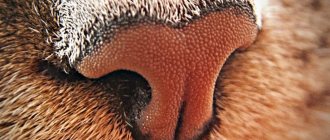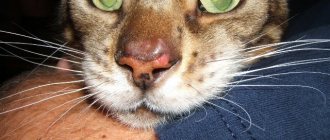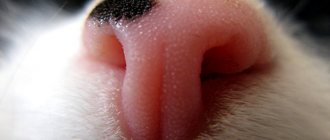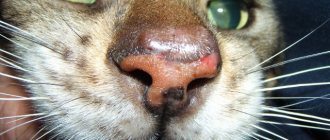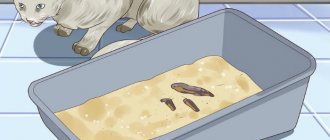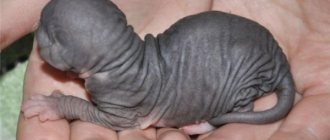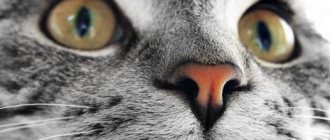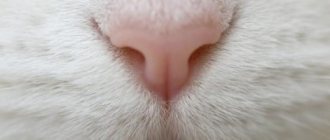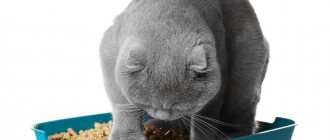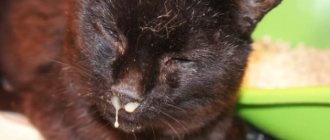Body temperature in cats is one of the main indicators of the health of a pet. Any deviations from the norm can signal various system failures, pathological processes in the animal’s body, provoked by disease.
If the animal’s condition has worsened, in order to notice the danger in time, cat owners must know how to measure their pet’s temperature, what body temperature should be normal for a cat, and what indicates health problems for their furry pet.
Why do cats have hot paw pads? If a cat has hot ears, what does it mean and what to do?
If a cat has hot ears, what does it mean and what to do?
Cats have a normal body temperature higher than humans, so sometimes your pet's ears may seem hot. To check if your pet is sick, you need to touch his nose; if it is wet and cool, then there is no need to worry. A dry and warm nose signals illness: - infection; - injuries; - inflammation; — diseases of the gastrointestinal tract; - stones in the bladder.
The pet's temperature is immediately measured; 38-39 is considered normal. Observe the behavior of the animal; if the cat has become lethargic, sleepy, and constantly lies down, then this indicates ill health. If you have any alarming symptoms, you should immediately contact your veterinarian. The pet needs to be given time, taken care of, and provided with proper care.
You can lower the temperature at home by using echinacea or astragalus tincture. The dose is calculated based on the weight of the animal, 8-10 drops of tincture per 10 kg. Give the cat a bowl of water, because at a temperature the pet will drink a lot.
If a cat has hot ears and paws, a warm dry nose, what does this mean?
A warm and dry nose combined with hot ears are signs that your pet is sick. The animal has an elevated body temperature, which is associated with diseases - infections, inflammation, gastrointestinal diseases.
If the cat's behavior is normal, without lethargy, then perhaps the pet is simply overheated. This is not scary, but it is still better to measure the temperature.
The cat has hot ears but a cold nose after childbirth, cesarean section, sterilization
After giving birth or cesarean section, cats may have a slight increase in temperature for a couple of days, this is not a cause for concern. Of course, if the ears are hot and the nose is wet and lethargic for several days, then it is possible that the pet has a very high fever and needs to immediately contact a veterinarian.
Sterilization should not cause a fever; the cat may have hot ears and a wet nose - this is normal. But if your nose is dry and hot, then you should immediately consult a doctor.
The cat has hot ears and head after castration, is a wet nose normal or not?
If a cat has been neutered, his ears may become warmer, but there should be no fever. Your pet needs supervision and care to make recovery from anesthesia easier. A wet nose and a hot head are an indicator that the cat does not have a fever.
The normal body temperature of a cat is 38-39.5°C. For a person, this temperature indicator is on the verge of critical. Therefore, touching a cat and feeling that the cat is hot
, the owners begin to panic.
Don’t be nervous right away, first measure your pet’s temperature - this is relative to your body temperature. The cat is hot
, but for him the temperature is within the normal range.
Also just a hot nose on a cat
, in the absence of any other symptoms, is by no means an indicator of ill health.
The cat has just woken up; in a few minutes the temperature balance will be restored. The animal is scared or nervous; stress is a common reason why a cat is hot.
The heat caused by these reasons, after a short time,
the cat's hot nose
will return to normal temperature.
Symptoms of fever in cats and kittens
But if the thermometer shows over 39.5°C, and the cat has hot ears and a dry nose,
There are reasons for concern, especially if you have symptoms such as:
- The cat refuses food and water; General lethargy, drowsiness; The cat's ears are hot
, red, swollen, with an unpleasant odor;
Hides from the light, from hands, behaves inappropriately; The cat's nose is hot and dry
, with dried purulent crusts;
Signs of a cold (sneezing, coughing, runny nose, eyes).
Explanation Why the Cat Is Hot
in this case, there can be one thing - there is an inflammatory process in the body.
The cat has hot ears
There are also other reasons:
- head and ear injury, infectious or viral disease;
When is there no reason to worry?
Hot paws in a cat do not always indicate a developing disease. The body temperature of an animal is higher than that of a person, so this condition does not always indicate pathology and in most cases is considered natural.
You should also not worry too much after walking in cold or hot weather. The pads quickly warm up after being outside, and this state lasts for at least an hour.
The exception is a walk in severe frost, which threatens frostbite on sensitive and unprotected skin. In this case, it is recommended to carefully examine the animal and if there are signs of hypothermia (change in skin tone, increased anxiety of the pet, the appearance of blisters or peeling), immediately go to the veterinarian.
Cats may also have hot paws from childhood. This phenomenon is considered normal; you should not use any medications to reduce the temperature. If there are no other signs of disease, the animal feels great, does not complain of appetite, and there is no need to worry.
What to do if the cat or kitten is hot?!
All of the above applies to kittens, but due to the development of the body, all sores are much more severe. The baby's immunity is fragile due to hormonal changes. Therefore, if the Kitten is hot, the kitten has a hot nose
, and when measuring the temperature you see frightening numbers on the thermometer, you can’t hesitate, the baby needs to be shown to the doctor.
Excessively hot paws on a kitten
also indicate an elevated temperature.
So, you discovered that the cat has a hot
Nose,
you noted an elevated temperature -
What to do
next?
The animal should be shown to a specialist as soon as possible.
In order not to drag a sick cat to the clinic, the best option is to call a veterinarian at home. The veterinarian comes to your home with all the necessary tools and medications to provide the necessary veterinary care.
The health and well-being of a cat is evidenced by an excellent appetite and cheerful state. A hot nose in a cat often signals some kind of health problem, although not always. There are several conditions and situations when a healthy cat's nose becomes dry and warm. In order not to make a mistake and accurately determine whether everything is fine with the pet, you need to understand this issue more deeply.
How to measure a cat's temperature correctly
Taking into account the individual characteristics of the body, in order to know what body temperature should be normal for a healthy cat, owners should take measurements in the morning and evening throughout the week. Write down the indicators in a notepad.
The procedure for measuring temperature is quite difficult and unpleasant for pets. It is carried out rectally. To measure indicators, purchase a mercury, electronic rectal thermometer from a veterinary pharmacy.
Advice! It is best to carry out the measurement procedure with an assistant. It is very important that the cat is securely restrained.
Sequencing:
- Lubricate the tip of the measuring device with Vaseline and baby cream. This will make it easier to insert into the rectum.
- Secure the animal on its side on a flat, hard surface. To prevent your cat from scratching you, you can swaddle it in a diaper or towel. It is permissible to measure the animal's temperature in a standing position.
- Hold your head by the scruff of the neck to prevent the cat from biting you. Move your tail to the side or lift it high. Make sure the cat doesn't escape. Talk to the animal in a gentle tone.
- Carefully insert the thermometer into the anus to a depth of two centimeters.
- After three minutes, you can evaluate the results obtained.
After thermometry, disinfect the thermometer with alcohol and reward your cat with his favorite treat. If you carry out the procedure systematically and treat your pet with a treat, the cat will perceive thermometry normally.
© shutterstock
Modern digital non-contact devices can also be used to measure temperature in animals . It is enough to bring the thermometer to the animal’s body for a few seconds. The screen will display the pet's actual temperature. The error is no more than 0.2 degrees.
Temperature monitoring in cats can also be done with an infrared ear thermometer. As the name suggests, the temperature is measured inside the ear. If there is no inflammation of the ears or otodectosis, the actual indicators can be increased by half a degree.
Knowing what a cat's normal temperature should be can help you avoid serious health problems.
A cat has a hot nose - reasons
If you find a hot nose on your cat, do not rush to panic. Probably the reason for this was something from this list:
- The cat recently woke up
- during sleep and immediately after, her nose remains warm and dry for some time;
The cat has experienced stress or has been actively playing
- a general increase in body temperature against this background also leads to a warming of the nose;
There is dry air in the room
- this problem is especially pressing in winter, when heating radiators are running, as well as in summer, when the air temperature is very high.
If the cat has no other signs of illness or illness, the condition of its mucous membrane and the outer surface of the nose will most likely return to normal after a short time. What does it mean if a cat has a hot nose for a long period of time (2-3 hours): there is probably a pathogenic bacillus in its body. In this case, pay close attention to see if your cat has any of the following signs, and if so, it’s time to see a veterinarian:
- refusal to eat, loss of appetite, or vice versa – insatiable appetite and thirst; high body temperature (above 40°C); dyspnea; runny nose, cough; vomiting, constipation, diarrhea; change in fur color, hair loss; drowsiness, apathy, anxiety, aggressiveness.
Hot nose in a cat after giving birth
Childbirth for a cat, like for a person, is a stressful situation. On the day the contractions begin, the cat becomes restless, walks around the room a lot, periodically trying on the prepared place - the “nest”. At the same time, the rectal temperature decreases by a couple of degrees. As the pain intensifies, her pulse and breathing rate increase. It is quite expected that a cat's initially cool or warm nose will gradually become hot. After labor is over, she will need some time to recover, after which the temperature of her body, nose and ears will return to normal.
If something went wrong during the birth of the kittens, there was an infection in the uterus or you see excessive bloody discharge, most likely her nose will be dry. In this case, a hot nose in a giving birth cat will indicate a general rise in temperature due to inflammatory or other painful processes in the body. To help her, you will need to contact a specialist.
The cat has a hot nose and is sneezing
Colds do not bypass our furry friends. Dry mucous membranes are not able to trap pathogens that penetrate the nasal passages, causing a response - sneezing. When a cat has a warm nose and is sneezing and snorting, he most likely has developed a cold. Additional symptoms are decreased activity and appetite, and a general increase in body temperature. Although sometimes sneezing is a sign of a foreign body getting into the nose. Or it could be a symptom of an allergy, such as to the chemicals you use when cleaning.
The cat is lethargic, the nose is dry and hot
Cats, like people, can freeze during a walk during the cold season or simply catch a cold in a draft. If you see that the cat has a hot and dry nose, he himself has become lethargic and apathetic, his appetite has decreased, this indicates the presence of a cold, viral or infectious disease. A competent veterinarian will be able to more accurately determine the disease and prescribe treatment.
What does it mean if a cat has a hot nose and diarrhea?
The cat is shaking with small tremors and a hot nose
When a cat has a warm nose (and even hot) and this is accompanied by trembling, the following conditions may be the cause:
Often, heavy breathing in cats, as in people, is associated with inflammation of the mucous membrane inside the nose and narrowing of the nasal passages. This happens with colds. There are other cases when heavy breathing is accompanied by the fact that the cat has a hot and dry nose, what does this mean:
- the animal probably has heart problems or pleurisy; perhaps the cat is simply scared, he is stressed, accompanied by a rapid heartbeat and rapid breathing; changes in breathing may be associated with overheating or hypothermia of the cat; in the presence of infections and viruses, diseases of internal organs, difficulty breathing becomes one of the indirect signs; with various injuries, especially if the chest is damaged, the animal’s breathing causes pain, it becomes heavy and uneven.
The cat has a hot nose and paws
We have thoroughly dealt with the question of why a cat has a warm nose. However, sometimes owners notice that their pet has hot paw pads and begin to panic. If we remember that cats have the only uncovered part of their body are their paws, and that their body temperature is normally 1-2 degrees higher than that of a human, then we can assume that in most cases the fears and fears of the owners are not well founded. It’s another matter if the animal’s general body temperature is higher than normal. Take a closer look at other symptoms of illness and, if necessary, contact a veterinarian.
Why does the cat have hot ears and nose?
When a cat has a warm, wet nose in combination with hot ears and this is not associated with banal overheating or stress, one of the following diseases can be suspected:
- inflammation; infection; gastrointestinal disease;
In what cases are hot ears a symptom of a disease?
If heating of the ears is accompanied by dark spots inside the ears, mucous discharge, vomiting, weakness and loss of appetite, diarrhea - these are already clear signs that the animal is sick. Most often, these symptoms occur when:
Ears can burn because the cat constantly scratches them - this occurs due to inflammation, otodectosis, ear infections or injuries.
Stress
Due to excitement, fear, and excitement, hormones are released, the pulse quickens, and blood pressure rises. Blood begins to flow faster through the vessels, causing the ears to quickly become hot. This is a short-term phenomenon - as soon as the animal calms down, the ears will cool down. But it happens that the animal is too worried and cannot come to its senses for a long time - this situation is dangerous and can lead to exhaustion (due to loss of appetite and insomnia) and cardiovascular pathologies. A pregnant cat may lose her kittens due to excitement.
Why does the kitten have a hot nose?
Kittens are very playful and active, they run, jump and play a lot. Because of this, it often happens that a kitten has a hot nose, and this is not at all a cause for concern. If you notice that his nose remains dry throughout the day, it’s time to start sounding the alarm. As a rule, in this case, on the second day, discharge appears from the nose - colorless or purulent. This is a sign of rhinitis - viral, allergic, bacterial or fungal. Sometimes the reason is a foreign body entering the nasal cavity or neoplasms in the sinuses and passages.
The cat has a hot nose - what to do?
If the cat has a hot nose and paw pads, and you do not have the opportunity to show your pet to a veterinarian, you can independently provide him with all possible help. Without harm to health, you can give it to a cat for children. A kitten can be given 1/6 of the tablet, an adult cat - 1/4 or 1/2. This drug is a good immunostimulant and has anti-inflammatory and antiviral effects. If you urgently need to reduce the temperature, you need to give an injection into the withers by adding 0.2 ml of no-shpu, analgin and diphenhydramine to the spitz.
A hot nose in a cat can be a symptom not only of a cold, but also of a more serious illness, so at the first opportunity it is better to show the animal to a veterinarian for tests and clarification of the diagnosis. Remember that with a prolonged increase in temperature, the body experiences dehydration, which can lead to weakness and death.
What to do if your cat has cold paws? This question causes great confusion if you have never paid attention to the temperature of your pet’s paws. To begin with, do not panic, even if your pet’s limbs become cold, identifying the cause and preventing the consequences is quite possible. The difficulty of diagnosis lies in the lack of anamnesis; the owner can remember whether the pet ate or drank, but not everyone can answer when and since when its paws get cold.
It’s hard to say how cold a cat’s paw pads are because a pet’s body can change by almost a degree during the day. Most cats' paws remain soft and sensitive even into adulthood. Animals that live outdoors have rougher paw pads, which means their nerve endings are not as sensitive to air temperature.
Normally,
the paw pads are slightly cooler than the body, but hotter than the air
. This situation persists for most of the day, since cats sleep or doze for up to 18 hours a day. It must be said that sleep and drowsiness are different states.
When dozing, the cat rests, but remains conscious, that is, this is one of the forms of wakefulness. Sleep is a state of rest and maximum relaxation, in which metabolism slows down, muscles rest, and the immune system works very actively. Since the Immunity is able to influence the base body temperature, a slight increase in it during sleep is the norm
.
There is also the opposite option - heat and physical activity also lead to cooling of the paw pads.
.
This happens because there are glands between the cat's toes that secrete fluid. Roughly speaking, the cat sweats with its paws
, the sweat evaporates and cools the skin. In long-haired pets, such phenomena are almost unnoticeable, since the liquid remains on the fur and practically does not cool the body.
Important!
When a cat sleeps, it should have warm paws, especially the pads of its toes.
Normal for a cat
In most cases, owners believe that if a cat has hot ears, then this is a significant sign of the pet’s health. This is usually true, but in some cases a cat’s ears become hot for external reasons: due to play, stress, etc. Such conditions are not dangerous and do not indicate a pet’s illness.
Temperature
Why do cats purr: what does it mean?
A cat's body temperature is usually 2° higher than that of a human. Some breeds (for example, the Sphynx) are characterized by a significant increase in temperature up to 39 ° C. Sometimes it is this fact that causes the owner to worry that not everything is all right with the pet. The thermoregulation mechanism of a cat is somewhat different from that of a human. Owners should take this into account.
Important! At different times of the day, depending on the condition of the animal, the temperature of the cat’s ears and nose changes.
The most popular situations when a cat’s condition is not painful, but only a consequence of an external factor:
Wet nose and ears
If a cat has a hot nose and ears, and after a short period of time (30-40 minutes) they return to normal, then the owner has nothing to worry about.
If your cat has a wet, hot nose and ears for an extended period of time, and there is a change in behavior, then contacting a veterinarian is recommended.
A hot nose and ears are a sign of a cat illness
A cat's hot, wet nose and hot ears are the following signs:
How to warm a cat's paws
As written above, your task is to determine the base body temperature and if it is normal, but the cat’s paws are still cold, you need to try to warm them. First, evaluate how warm it is in the home and how the pet behaves:
- Does the cat walk on the floor or prefer to move on the top? The higher you go, the warmer the air.
Perhaps your pet is freezing?
- Perhaps the cat was moulting and the weather suddenly got colder - our pets are warmed by the undercoat, not the guard hair.
- Does your pet climb into your bed to sleep? If so, she is looking for additional heat sources
.
The best option is Insulated with a thick backing
. Recently, recommendations have appeared on forums about insulating houses with heat-insulating fabric. Yes, it doesn’t look very attractive, but you can’t lure cats out of their warm nests.
Note!
During sleep, the temperature and heat transfer of a cat’s body increases, therefore (if the house is cold) the pet may freeze in its sleep.
How to help an animal
Hot ears in a cat are not a pathology in themselves, which means that trying to cool only one ear (for example, by applying ice compresses) is pointless. The first thing to do is to examine the animal for other symptoms. If they are not there, then you should leave the cat alone for 20–30 minutes and feel the ears again - in a healthy animal, by this time the blood flow will normalize and the skin will no longer be hot.
When fiery ears are still a symptom of some kind of disease, it is necessary to begin treatment. It depends on the diagnosis:
Kot Bayun is a sedative medicine based on natural herbal ingredients
Amitrazine is a veterinary drug that is used for cats in the treatment of pathologies caused by sarcoptic mites
During treatment of otitis media, ear mite infection, and after surgery, the cat must be wearing a medical collar that prevents the animal from scratching the sore ear.
If the cat has a fever
If the ears are hot, you need to make sure that the animal’s body temperature is normal. If you don’t have a thermometer, just feel the animal’s nose - it should be cold and wet when awake. If you have a temperature measuring tool at home, you should use it. For an adult cat, readings below 37.5˚C and above 40˚C are a serious reason to immediately contact a veterinarian. Fever occurs when:
Video: how to correctly measure a cat's temperature
Sometimes an emergency situation arises when it is impossible to quickly get an appointment with a specialist. Inaction during hyperthermia is dangerous, therefore the following measures are allowed to eliminate fever:
Remember, fever is a dangerous symptom. Even if you manage to knock it down, it is very important to take your cat to the vet as soon as possible. He will conduct an examination and find out the exact cause of the fever, which will help prescribe the correct treatment.
Many cat owners panic if their pets' ears become hot. But, according to experts, flaming ears themselves are not a reason to suspect a disease. You need to worry if the animal's general body temperature rises, it itches constantly, refuses to eat, and sleeps poorly. Such symptoms are already a reason to visit a veterinarian, find out the reason for the cat’s poor health and immediately begin treatment.
Source
Possible ailments
Cold extremities can indicate a number of ailments that may occur slowly or even unnoticeably. To compile an anamnesis, you need to observe your pet for 3-4 days, recording changes in the temperature of the paws.
Cooling of the extremities after or after
, used for other purposes. Narcosis is a drug and the body is in a state of severe intoxication. Reduced body temperature protects the brain from the harmful effects of the chemical components of the drug. Even in the summer, after anesthesia, it is recommended to keep the cat on a heating pad until it comes to its senses and goes to a cooler place.
For many owners, cats become full-fledged members of the family. They worry when their pets feel unwell, lose their appetite, and become lethargic. Often cat owners focus on their pet's nose. In this article we will talk about what to do when a cat has a dry nose and why this happens.
Many owners are concerned with the question of what a healthy kitten’s nose should be like. First of all, a healthy nose is a moist and cool nose that glides a little. This is due to the nature of the animal. In fact, cats are predators for whom the nose is the main assistant in the hunt. The wet organ helps determine where the wind is blowing - this is necessary so that the victim does not smell the cat's scent. This is why having a wet nose is important.
When determining the health of a pet, it is necessary to take into account the type of activity of the kitten. If he has just woken up or was engaged in active play, then he may experience a dry nose. This is due to the fact that pets have a higher body temperature than their owners, and therefore moisture evaporation occurs more intensely. Physiological causes of dryness are:
- awakening; active games; hot room; sharp fear; prolonged exposure to the sun; sedentary lifestyle.
Pathological conditions
Cold paws can also indicate a number of diseases or pathological conditions. Thus, persistent coldness of the extremities is observed:
- In the postoperative period upon recovery from anesthesia. This is why veterinarians recommend keeping an unconscious cat on a heating pad even on a summer day.
- Due to external or internal bleeding, since blood loss leads to a decrease in circulating blood volume.
- When dehydrated. Severe diarrhea and vomiting can lead to disruption of the water-salt balance in the body and thickening of the blood. To stabilize the condition, urgent administration of saline solutions orally, subcutaneously or intravenously is necessary.
- In case of poisoning. Severe intoxication may be accompanied by depression of brain and cardiac activity, salivation, pale gums, and indigestion.
- For hypo- or hyperglycemia. A significant jump in blood glucose levels leads to various metabolic disorders and coma.
- For exhaustion and anemia. If your cat looks gaunt and thin, then she may have problems digesting food. Vitamin deficiencies, problems with fermentation, anemia, and helminthiasis lead to such conditions.
- For cardiovascular diseases, including congenital valvular malformations, vascular spasms, cardiomyopathy in old animals.
- In the terminal stage of infectious diseases, when the body temperature drops and the activity of all systems declines.
It is the owner's duty to note any suspicious changes in the furry pet's condition and contact a veterinarian before it is too late.
What are the signs that require contacting a veterinarian?
If the following symptoms are detected in a kitten, you should consult a veterinarian to identify the causes of your pet’s illness:
- malaise, lethargy, apathy; dry and hot nose; cold and pale nose; change in organ color (blue, yellowish, red, white).
The owner should know that a pale and cold organ in a kitten is a sign of:
- chronic illness; hypothermia; stress; low body temperature; poisoning; complete lack of appetite.
A white and warm nose is a sign of a disruption in the kitten’s circulatory system. The blue and hot organ talks about:
- heart failure; inflammation of the respiratory organs; oxygen starvation.
When a kitten has a hot and red organ, this is a sign:
- infectious disease; rhinitis; mechanical damage.
If a kitten has a hot, dry nose and warm ears, then this is not necessarily a sign of illness, because heat exchange has not yet been established in babies, and their body temperature is higher than that of an adult pet. This may be due to the work of the body and its protection from hypothermia.
Pathological conditions
Cold paws can also indicate a number of diseases or pathological conditions. Thus, persistent coldness of the extremities is observed:
- In the postoperative period upon recovery from anesthesia. This is why veterinarians recommend keeping an unconscious cat on a heating pad even on a summer day.
- Due to external or internal bleeding, since blood loss leads to a decrease in circulating blood volume.
- When dehydrated. Severe diarrhea and vomiting can lead to disruption of the water-salt balance in the body and thickening of the blood. To stabilize the condition, urgent administration of saline solutions orally, subcutaneously or intravenously is necessary.
- In case of poisoning. Severe intoxication may be accompanied by depression of brain and cardiac activity, salivation, pale gums, and indigestion.
- For hypo- or hyperglycemia. A significant jump in blood glucose levels leads to various metabolic disorders and coma.
- For exhaustion and anemia. If your cat looks gaunt and thin, then she may have problems digesting food. Vitamin deficiencies, problems with fermentation, anemia, and helminthiasis lead to such conditions.
- For cardiovascular diseases, including congenital valvular malformations, vascular spasms, cardiomyopathy in old animals.
- In the terminal stage of infectious diseases, when the body temperature drops and the activity of all systems declines.
It is the owner's duty to note any suspicious changes in the furry pet's condition and contact a veterinarian before it is too late.
What signs will help determine the onset of the disease?
In addition to the signs listed above, the kitten also exhibits other symptoms indicating the onset of the disease. These include:
- increasing or decreasing the number of trips to the toilet; diarrhea or bloody stools; vomit; increased anxiety of the animal; hair loss; increased thirst; cardiopalmus; deep breathing; nasal discharge.
If you have these symptoms, you should consult a specialist; only he can make a correct diagnosis and prescribe treatment. You should not self-medicate, as this will only worsen the situation.
Often a kitten's dry nose is an indicator of intestinal problems, namely the presence of hair in the gastrointestinal tract. This is the only indicator of this problem.
What should the owner do to help the cat?
The first thing the owner needs to do if he discovers a dry nose in a cat is to observe its general condition. Maybe she had a fever. Hot ears confirm the presence of a high temperature. It would be useful to take your temperature several times a day; this should be done rectally. Readings up to 37-38 degrees are considered normal; if it rises above 38.5, then you need to contact a veterinarian. When a kitten’s temperature reaches too high, you can help him with the following manipulations:
- wet the kitten’s fur with water from time to time; place a cold pack under the neck or on the inner thigh; provide access to clean and fresh water.
Only a veterinarian can determine why the temperature has risen, and only he can give advice on the choice of antipyretic drugs.
Now you know why a cat has a dry nose. There can be many reasons for this, and they are not always signs of illness. If they coincide with a dry nose, then you should not wait for the kitten’s well-being to improve on its own and it is better not to postpone a visit to the veterinarian.
What body temperature is considered normal for a kitten and an adult cat?
A cat's body temperature depends on many factors:
This is not a constant value. During the day, this parameter usually changes. Normally, they can deviate from the standard values by no more than 0.5°C up or down. Information on the acceptable values of this indicator for healthy representatives of the cat family is presented in the table:
| Age and physiological state of cats | Normal values, degrees | |
| Bottom line | Upper limit | |
| Newborn kittens | 40 | 40,5 |
| Grown up cubs | 38,5 | 39,5 |
| An adult animal in a state of wakefulness | 38 | 39 |
| Prenatal period | 37 | 39 |

